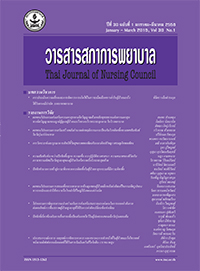ปัจจัยที่เกี่ยวข้องกับการสื่อสารเพื่อป้องกันเอชไอวีในผู้ปกครองของ เด็กวัยรุ่นตอนต้น
Keywords:
การป้องกันเอชไอวี, การสื่อสาร และเด็กวัยรุ่นตอนต้น, HIV prevention, communication, young adolescentAbstract
บทคัดย่อ: วัตถุประสงค์ของการวิจัย: ศึกษาปัจจัยที่เกี่ยวข้องกับการสื่อสารเพื่อป้องกันเอชไอวีในผู้ปกครองของเด็กวัยรุ่นตอนต้น
การออกแบบงานวิจัย: การวิจัยเชิงพรรณนาหาความสัมพันธ์
การดำเนินการวิจัย: กลุ่มตัวอย่างเป็นผู้ปกครองที่มีบุตรหลานที่กำลังศึกษาอยู่ในชั้นประถมศึกษาปีที่ 4 ถึง 6 ในจังหวัดเชียงใหม่ จำนวน 345 คน เก็บข้อมูลโดยใช้แบบสอบถามประกอบด้วย แบบสอบถามความรู้เรื่องการป้องกันเอชไอวี แบบสอบถามการพูดคุยเรื่องการป้องกันเอชไอวี และแบบสอบถามความสะดวกใจในการพูดคุยเรื่องการป้องกันเอชไอวี วิเคราะห์ข้อมูลโดยหา ค่าร้อยละ ค่าเฉลี่ย ส่วนเบี่ยงเบนมาตรฐาน และค่าสัมประสิทธิ์สหสัมพันธ์ของสเปียร์แมน
ผลการวิจัย: ผู้ปกครองประมาณครึ่งหนึ่งมีการพูดคุย (ร้อยละ 48.98) และมีความสะดวกใจในการพูดคุยเรื่องการป้องกันเอชไอวีกับเด็กวัยรุ่นตอนต้น (ร้อยละ 53.62) อยู่ในระดับมาก นอกจากนี้ยังพบว่าความรู้เรื่องการป้องกันเอชไอวีมีความสัมพันธ์ทางบวกในระดับสูงกับการสื่อสาร การศึกษากับรายได้มีความสัมพันธ์ทางบวกในระดับตำ่กับความสะดวกใจในการพูดคุยอย่างมีนัยสำคัญทางสถิติ
ข้อเสนอแนะ: ควรมีการพัฒนารูปแบบและกลยุทธ์ในการเสริมสร้างให้ผู้ปกครองมีความรู้และทักษะในการสื่อสารเรื่องการป้องกันเอชไอวีกับเด็กวัยรุ่นตอนต้น
Abstract: Objective: To examine factors related to communication between young adolescents and their parents regarding prevention of HIV.
Design: Descriptive interrelationship study.
Implementation: The subjects were 345 parents whose children were studying in grades 4 to 6 in Chiang Mai province. Data were collected using a set of three questionnaires designed to acquire information on (i) HIV-prevention knowledge; (ii) HIV-prevention conversation; and (iii) comfortableness with HIV-prevention conversations. The data were statistically analysed in terms of percentage, mean, standard deviation and Spearman’s Rank Correlation Coefficient.
Results: The study showed that almost half of the parents were engaged in HIV-prevention conversations (48.98%), and 53.62% displayed a high degree of comfortableness with having HIV-prevention conversations with their young adolescent children. In addition, a significantly high degree of positive relationship was found between knowledge of HIV prevention and communication, whereas a significantly low degree of positive relationship was found between comfortableness with having HIV-prevention conversations and the factors of education and income.
Recommendations: It is advisable that methods and strategies be developed for the purpose of equipping parents with proper knowledge and skills in communicating HIV-prevention issues with their young adolescent children.








